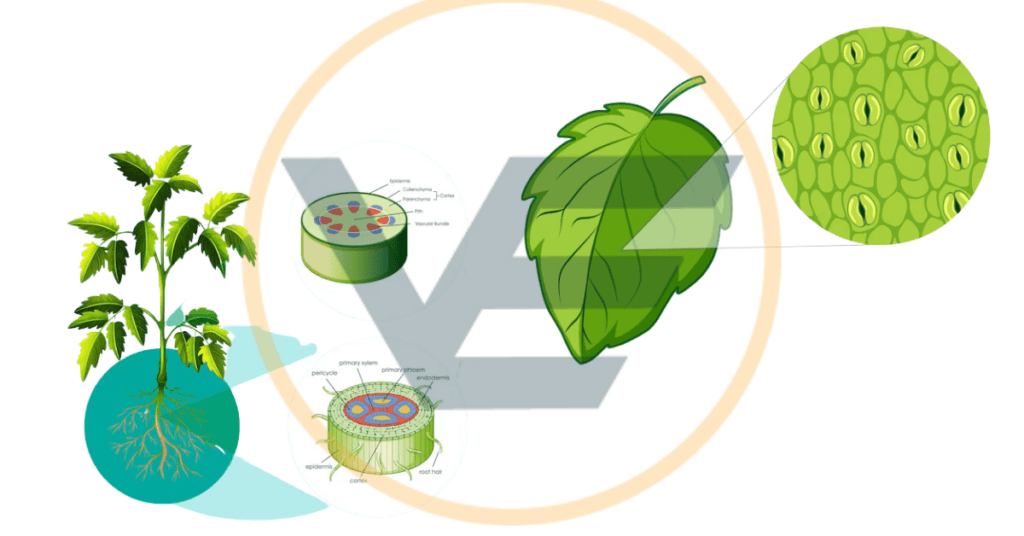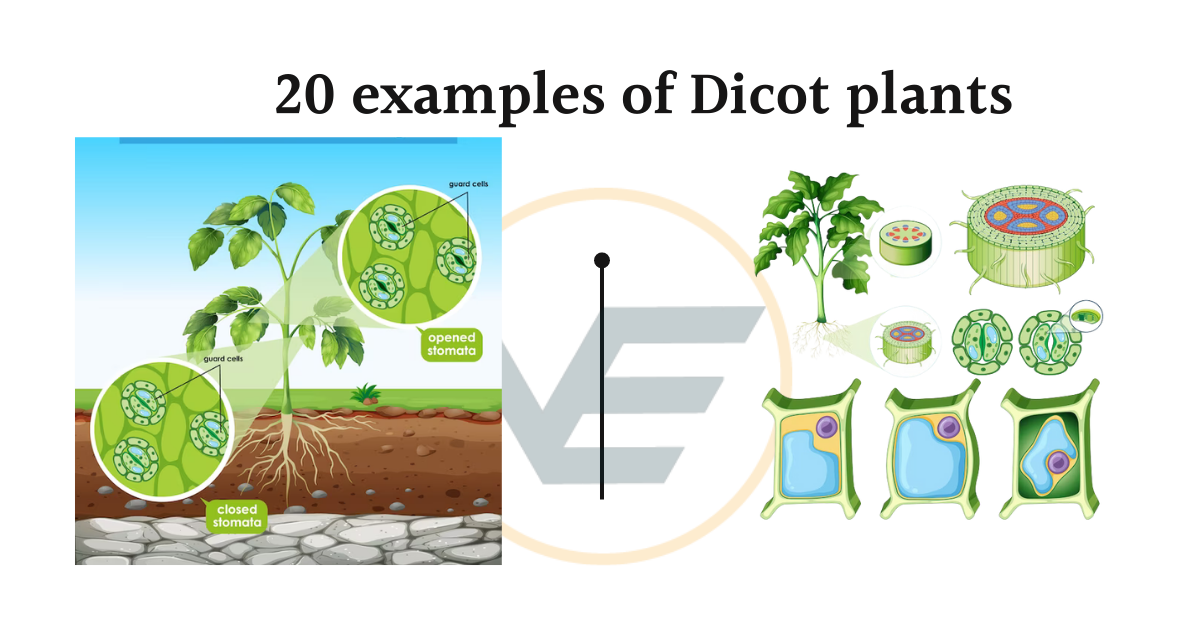Dicot plants, short for dicotyledonous plants, are a group of flowering plants that belong to the class Magnoliopsida. They are one of the two main categories of angiosperms (flowering plants), the other being monocotyledonous plants (monocots). Dicotyledons are characterized by having two cotyledons (seed leaves) in their embryos.
Key Characteristics of Dicot Plants:
- Leaves: Dicot plants typically have leaves with a network of veins, often branching out from a central midrib. The leaf arrangement on the stem is usually opposite or alternate.
- Flowers: Flowers of dicot plants usually have their floral parts (petals, sepals, stamens, and pistils) in multiples of four or five.
- Vascular Bundles: Dicot stems possess vascular bundles arranged in a ring, with cambium between the xylem and phloem tissues, allowing for secondary growth.
- Roots: Dicot roots generally consist of a central taproot that develops from the primary root, along with smaller lateral roots.
- Seed Structure: Dicot seeds have two cotyledons that serve as food storage for the developing embryo.
- Growth: Dicot plants often exhibit secondary growth, meaning they can increase in girth over time due to the activity of lateral meristems.
- Life Cycle: Dicots undergo sexual reproduction through flowers and produce seeds enclosed within fruits.
Importance of dicot plants in various ecosystems
Dicot plants play essential roles in various ecosystems, contributing to the overall health and functioning of the environment. Their significance stems from their diverse characteristics and ecological interactions. Here are some key points highlighting the importance of dicot plants in ecosystems:
- Biodiversity Support: Dicot plants are a crucial component of biodiversity in terrestrial ecosystems. They provide habitat and food sources for a wide variety of animals, including insects, birds, mammals, and other plant-eating organisms. The presence of dicot plants enhances species diversity and promotes ecological balance.
- Soil Stability and Erosion Control: Dicot plants with deep root systems, such as trees and shrubs, help stabilize soil and prevent erosion. Their extensive root networks bind soil particles together, reducing the risk of soil erosion caused by water or wind.
- Carbon Sequestration: Dicot plants, especially trees, are excellent carbon sequestrators. Through photosynthesis, they absorb carbon dioxide from the atmosphere and store carbon in their tissues, mitigating the greenhouse effect and combating climate change.
- Nutrient Cycling: Dicot plants actively participate in nutrient cycling within ecosystems. When they shed leaves or die, their organic matter decomposes, releasing nutrients back into the soil. These nutrients become available for uptake by other plants and contribute to the overall nutrient cycling process.
- Pollination and Reproduction: Many dicot plants rely on pollinators, such as bees, butterflies, birds, and other insects, for their reproduction. These plants provide nectar and pollen as food sources, fostering mutualistic relationships with pollinators and facilitating successful seed production.
- Food Web Dynamics: Dicot plants serve as primary producers in food webs, converting energy from sunlight into biomass. They form the foundation of various food chains and support herbivores, which, in turn, sustain predators and other consumers higher up in the food chain.
- Wildlife Habitat: Dicot plants, particularly trees, offer vital habitat and shelter for a wide range of wildlife. Forests, woodlands, and shrublands provide nesting sites, food sources, and protection for countless animal species, contributing to ecosystem diversity.
- Medicinal and Economic Value: Many dicot plants have medicinal properties and are used in traditional medicine and pharmaceuticals. Additionally, dicot crops such as potatoes, tomatoes, beans, and fruits are staples in human diets, providing sustenance and economic value.
- Water Regulation: The presence of dicot vegetation in riparian zones and wetlands helps regulate water flow and reduce the risk of flooding by absorbing excess water during heavy rainfall and releasing it gradually.
- Aesthetic and Recreational Value: Dicot plants, especially ornamental flowers and trees, enhance the aesthetic appeal of natural landscapes and urban environments. They provide recreational opportunities for outdoor activities and improve the overall well-being of people.

Examples of Dicot plants
Here are 20 examples of dicot plants:
- Rose (Rosa spp.): Known for their beautiful flowers and fragrance, roses are popular ornamental plants.
- Sunflower (Helianthus annuus): Sunflowers are large, vibrant flowers cultivated for their edible seeds and oil.
- Tomato (Solanum lycopersicum): Widely consumed as a fruit but classified as a vegetable, tomatoes are essential in various cuisines.
- Potato (Solanum tuberosum): A staple food crop worldwide, potatoes are a significant source of carbohydrates.
- Pea (Pisum sativum): Peas are leguminous vegetables rich in protein and dietary fiber.
- Bean (Phaseolus vulgaris): Beans are nutritious legumes with high protein content, available in various types like kidney, black, and navy beans.
- Oak (Quercus spp.): Oaks are large, long-lived trees providing essential habitat and food for wildlife.
- Maple (Acer spp.): Maples are deciduous trees appreciated for their vibrant autumn foliage.
- Rosemary (Rosmarinus officinalis): A fragrant herb commonly used in culinary dishes and herbal remedies.
- Soybean (Glycine max): Soybeans are versatile legumes used for various products, including tofu and soy milk.
- Cabbage (Brassica oleracea): Cabbage is a nutritious vegetable commonly used in salads and cooking.
- Apple (Malus domestica): Apples are a popular fruit worldwide, consumed fresh or processed into various products.
- Peanut (Arachis hypogaea): Peanuts are legumes grown for their nutritious kernels and used in foods like peanut butter.
- Carrot (Daucus carota): Carrots are root vegetables rich in beta-carotene and essential nutrients.
- Cotton (Gossypium spp.): Cotton plants are the source of the widely used natural fiber for textiles.
- Cherry (Prunus avium): Cherries are sweet and tart fruits enjoyed fresh or processed into jams and desserts.
- Cucumber (Cucumis sativus): Cucumbers are refreshing vegetables often consumed raw or pickled.
- Pomegranate (Punica granatum): Pomegranates are fruits known for their juicy arils and antioxidant properties.
- Rosehip (Rosa canina): Rosehips are the fruit of certain rose species, often used in herbal teas and supplements.
- Alfalfa (Medicago sativa): Alfalfa is a valuable forage crop, widely used as animal feed.
Importance of Dicot Plants:
- Food Source: Many dicot plants provide essential food resources for humans and animals. They include staple crops like potatoes, tomatoes, beans, and peanuts.
- Biodiversity: Dicot plants contribute to biodiversity by providing habitat and food sources for various animal species.
- Ecological Balance: Dicot plants play a role in ecological balance, as they participate in nutrient cycling and soil enrichment.
- Economic Value: Dicot plants have significant economic value. For example, cotton is a vital crop for the textile industry.
- Medicinal Use: Several dicot plants have medicinal properties and are used in herbal remedies and traditional medicine.
- Erosion Control: Dicot plants with deep root systems, like oaks and maples, help prevent soil erosion.
- Aesthetics: Dicot plants are widely used in landscaping and gardening to enhance the beauty of outdoor spaces.
- Pollinator Support: Many dicot plants attract pollinators like bees and butterflies, contributing to pollination and plant reproduction.
In summary, dicot plants are essential components of ecosystems and human society. They provide food, shelter, and numerous other benefits, making them vital for the environment and human well-being.

